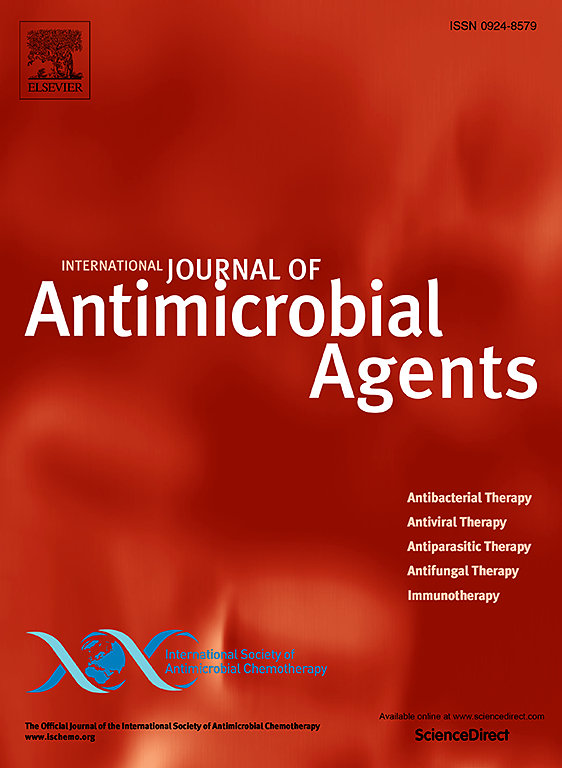Antimicrobial suppressive therapy in prosthetic valve endocarditis rejected from surgery despite indication
IF 4.6
2区 医学
Q1 INFECTIOUS DISEASES
International Journal of Antimicrobial Agents
Pub Date : 2025-04-29
DOI:10.1016/j.ijantimicag.2025.107526
引用次数: 0
Abstract
Background
Prosthetic valve endocarditis (PVE) incidence is rising in older patients, often rejected for surgery, leading them to a poor prognosis. Optimal antibiotic management is unknown for these patients. We compared the efficacy and safety of suppressive (SAT) versus conventional antimicrobial therapy (CAT) in this setting.
Methods
We conducted a prospective, multicentric, cohort study in southwest France including patients with PVE rejected from surgery despite indication, and surviving the initial 6 weeks of intravenous therapy. Beyond this period, patients could or not receive SAT, according to endocarditis team decision. Primary outcome was a composite endpoint of one-year all-cause mortality and PVE-related hospitalization. Secondary outcome was the incidence and nature of SAT-related adverse events.
Results
Between 2012 and 2022, 88 patients were included in the study, 42 receiving SAT and 46 CAT. Mean age was 69.4 ± 16.4 years and patients were highly comorbid (mean Charlson Comorbidity Index 5.6 ± 2.7). Main organisms included Streptococcus spp. (26/88, 29.5%) and Staphylococcus aureus (25/88, 28.4%). The primary composite outcome occurred in 7/42 (16.7%) patients in the SAT group, and 16/46 (34.8%) in the CAT group. Using a Cox model, SAT was significantly and independently associated with a lower incidence of one-year primary outcome (Hazard ratio 0.23, 95% CI 0.08–0.67, P = 0.007). Adverse effects in the SAT group were reported for 6/42 patients (14.3%). These effects were limited, causing only one treatment discontinuation.
Conclusion
In patients with PVE rejected from surgery despite indication, SAT may be safe and associated with better outcomes than CAT.

人工瓣膜心内膜炎的抗菌抑制治疗尽管有指征但仍被手术拒绝。
背景:人工瓣膜心内膜炎(PVE)在老年患者中的发病率正在上升,这些患者往往拒绝手术,导致预后不良。这些患者的最佳抗生素管理尚不清楚。在这种情况下,我们比较了抑菌治疗(SAT)与常规抗菌治疗(CAT)的疗效和安全性。方法:我们在法国西南部进行了一项前瞻性、多中心、队列研究,纳入了尽管有适应证但仍拒绝手术的PVE患者,这些患者在静脉治疗的最初6周内存活。根据心内膜炎小组的决定,在此期间,患者可以或不接受SAT治疗。主要终点是1年全因死亡率和pve相关住院率的综合终点。次要结局是sat相关不良事件的发生率和性质。结果:2012年至2022年间,88例患者纳入研究,42例接受SAT治疗,46例接受CAT治疗。患者平均年龄69.4±16.4岁,合并症高(平均Charlson合并症指数5.6±2.7)。主要病原菌为链球菌(26/88,29.5%)和金黄色葡萄球菌(25/88,28.4%)。SAT组有7/42(16.7%)患者出现主要复合结局,CAT组有16/46(34.8%)。使用Cox模型,SAT与较低的1年主要结局发生率显著且独立相关(风险比0.23,95% CI 0.08 - 0.67, p=0.007)。SAT组有6/42例(14.3%)患者报告了不良反应。这些影响是有限的,仅引起一次停药。结论:对于尽管有适应证但仍拒绝手术的PVE患者,SAT可能是安全的,并且与CAT相比具有更好的预后。
本文章由计算机程序翻译,如有差异,请以英文原文为准。
求助全文
约1分钟内获得全文
求助全文
来源期刊
CiteScore
21.60
自引率
0.90%
发文量
176
审稿时长
36 days
期刊介绍:
The International Journal of Antimicrobial Agents is a peer-reviewed publication offering comprehensive and current reference information on the physical, pharmacological, in vitro, and clinical properties of individual antimicrobial agents, covering antiviral, antiparasitic, antibacterial, and antifungal agents. The journal not only communicates new trends and developments through authoritative review articles but also addresses the critical issue of antimicrobial resistance, both in hospital and community settings. Published content includes solicited reviews by leading experts and high-quality original research papers in the specified fields.

 求助内容:
求助内容: 应助结果提醒方式:
应助结果提醒方式:


